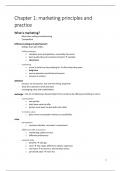Chapter 1: marketing principles and
practice
What is marketing?
- More than selling and advertising
- Competition
Difference selling and advertisement
- Selling: start with offers
- Selling strategy:
o cheapest price (competition, eventually free wins)
o best quality (how do customers know?) → samples
o short term
- marketing:
o invest in what are they looking for → offer what they want
o long term
o pursue questions and demand answers
o answers in actions
definition
- process: no transaction, not one time thing, long term
- what the customers need and want
- exchanging value with stakeholders
exchange = the act of obtaining a desired object from someone by offering something in return
- voorwaarden
o two parties
o both have value to offer
o parties must want to deal with each other
- it creates value
o gives more consumption choices or possibilities
value
- perceptions
o customer decides, consumer’s assessment
- difference with economics
o maximizing utility not true
o different preferences
- example tesla
o benefits → safe gas
o costs → low range, difficult to obtain, expensive
o real value → economics: not the best choice
o perceived value → more fun
1
, - example royal mail
o more expansive stamp: guarantee of delivery the next day (97%)
o economics: fact to 100% so best utility → no one believes it’s more than 60%
o not about actual performance, yet about perceptions
o royal mail: better than the german mail → perceptions of good and fast mail
(punktlichkeit)
different types of products
- physical products
- Services
- Retail
- Experiences
- Events
- Film, music, theatre
- Places (tourists, attract business, attract people, attract investors, …)
- Ideas (drink and drive, safety jackets, …)
- Charities and no-profits (ice bucket challenge for ALS, de warmste week, …)
- People (polititions, tinder, jobmarket, oral exam, …)
Difference between customer and consumer?
The difference
- Sometimes they are the same, sometimes
Consumers buying roles
- Initiator
o They first come up with the idea
- Influencer
o Social media, influence where you go, effect your decision
- Decider
- Buyer
o The one who purchases the product
o Example: dogfood (what do they like?)
- Payer
- User
o Consumes
- Gatekeeper
o Help control access
- Example: old spice
o Deodorant for men: advertisement with woman
o Women buy deodorant for men → no advertisement with woman → advertisement
with hot men
o Advertisement targets the buyer, not the user
Market orientation
- Organization-wide belief in delivering consumer value
- Focus on customers needs, also the needs from the future (existing and latent needs)
2
, - Predict the underlying needs from the customers
- Thinking outside the box
- 3 types
o Customer orientation
o Competitor orientation
o Interfunctional coordination: everybody in the company is on board
- Customer centricity
o Not trying to please everybody
o Fulfilling needs in a profitable way
o Vb.: amazon prime (only 23% wants to pay extra)
o Vb.: amazon key (delivery inside your house)
Marketing’s intellectual roots
- Industrial economics
o Supply and demand
o Theory of income distribution, competition, monopoly
- Psychological
o Consumer behavior, motivation research
o Persuasion, personality
- Sociological
o Behaviour of groups
- Anthropological
o Qualitative approaches researching peoples behaviour
- Computer science
o Digitalization, apps, recommendation systems
Tip of the ice berg
- We don’t see the strategies behind the advertisements
- Zara vs Benetton
o Zara: more known, stock price is higher, positioning (cheaper), fomo (a lot of
different collections, who change fast), trend in society, control in all their own
stores, distribution and production is all in hands of zara,
o Benetton: higher quality, better (shocking) advertisement (united colours of
Benetton) → advertisement not visible in the colections
o The aim of marketing is to make selling superfluous: making marketing over
What do marketers do?
Insides
- Information about the customers
- Defend customers needs in front of the company
3
, Advocate of the customer
Marketing mix
-
- Program into action
- Core
o Who are we going to sell to?
o And how are we different?
- Technical
o Deal with bad press
o Brand
o Product management
- Behavioral
o Inspire people
o Innovation
Marketing within organizations
- Develop enhancing a firm’s relationships with its customers and terms inside companies
Marketing as exchange
Evolving
-
- Co-creation
o = Active involvement of the stakeholders
o Value for value
o Both from organization to stakeholders and back
o Stakeholders = investors, students, parents, teachers, government, press,
Value
- Value from stakeholders other than purchases
4




